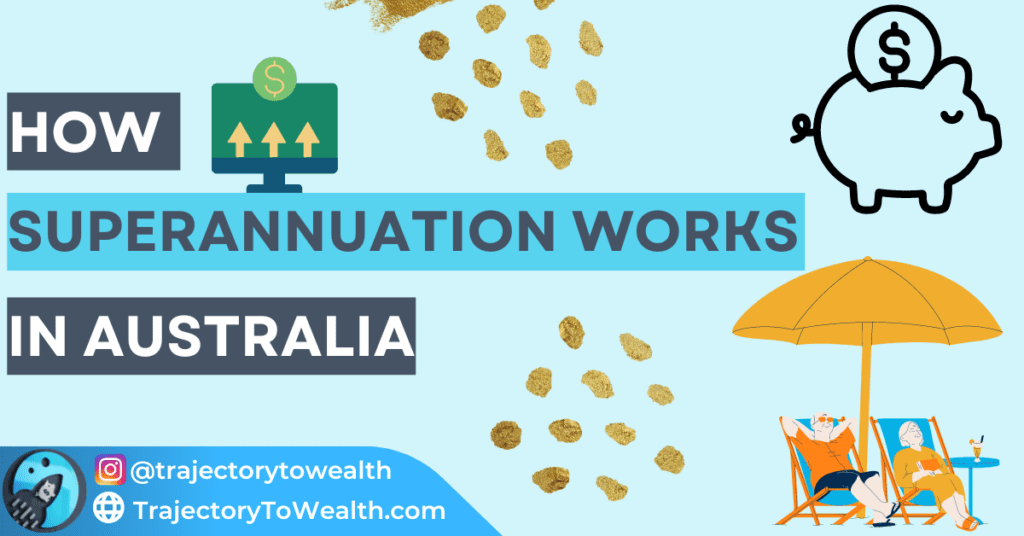How Superannuation Works In Australia.
Superannuation is one of the most important financial tools at your disposal, and understanding it can save you thousands, if not hundreds of thousands of dollars in the long-run.
Super At A Glance
- Superannuation, or ‘super’, is money put aside by your employer over your working life for you to live on when you retire from work.
- The super guarantee requires employers to contribute 10.5% of your income into your super account on top of your salary.
- For the most part, you can only access the funds inside your super account when you reach retirement age or in special circumstances, such as buying your first home.
- You can think of superannuation providers as hedge fund managers. Often super funds will have high fees or investment portfolios that are ‘actively’ managed.
- Most super funds offer a low-cost ‘passive’ investment option that has much lower fees
- Passive investment portfolios track the performance of the stock market and don’t require any active involvement by fund managers, which is why they often have much lower fees.
Often super is overlooked by many people, either because it seems complicated or purely because they ‘don’t care about it’. However, super is one of the most important financial tools at your disposal, and understanding it can save you thousands, if not hundreds of thousands of dollars in the long-run.
If you’re employed full-time and working in Australia, superannuation is one of the best financial concepts to grasp and understand to set yourself up for a wealthy retirement.
What Is Super?
There are several reasons why super is incredibly important, but how much about it do you actually know?
Superannuation (or ‘super’) is money set aside while you’re working to support your financial needs in retirement. Your super is invested in a range of assets to help grow your balance so you can have the best possible retirement outcome.
How Superannuation Works
- From 1 July 2022, when you start working your employer has to start contributing to your super if you’re 18 years or older.
- Your savings grow because your employer pays a compulsory sum of money into your super account. This sum, called the Superannuation Guarantee, is 10.5% of your before tax income.
- You can add more money to your super by choosing the option that works best for you like before or after tax contributions.
- You can only access the funds inside your super account when you reach retirement age, or in exceptional circumstances such as buying your first home, or if you’re suffering from financial hardship.
Is Super Really That important?
Often you will hear, ‘Super isn’t all its cracked up be” or “super is overrated”.
But for all the trash that’s talked about super, it still is and will continue to be hands-down the greatest tax dodge you can legally get your hands on.
That’s because while the top tax rate for individuals can reach up to 45%, you only pay 15% tax on the money that goes into your super fund (up until a certain amount). That’s up to 30% off your money that can be saved instantly just for leveraging the power of super.
Superannuation Misconceptions
To understand why super is so important, let’s look at some misconceptions or common thoughts about super.
You: I don’t really pay much attention to my super.
Oh yes you do – whether you know it or not. Here in Australia, the Government doesn’t trust you to take care of your retirement yourself, so they force your employer too.
So if you work full time in Australia, then last month alone 10% of your wage went into your super account. It’s called the ‘Super Guarantee’ or in other words – compulsory superannuation.
What do I mean by this?
In Australia, employers are required by law to contribute, at minimum, 10.5% of your annual income into your super account each year. So say you earn $100,000 each year, your employer has to contribute $10,500 (10.5%) into your super account.
But even if you don’t earn $100,000 a year, the percentage stays the same – 10.5% of your annual before-tax salary still goes into your super account. And that’s a hefty amount no matter what you’re earning.
Yet the overwhelming majority of people don’t even spend 5 minutes thinking about which super fund they should choose to direct their money into…
Does something like this sound familiar?
You: “Ugh, I don’t know anything about super nor do I care, so I’ll just go with the fund offered by my employer”, or, “I’ll just use the super account that was set up for me when I started my first ever job at the fruit market 10 years ago”.
But that’s not even the worst part! The average Aussie has up to four different super funds which they’ve set up from different employers over their working career. This means they’re paying fees on every account, 4 times more than necessary!
Because of this, the head honchos (fund managers) running the show make a combined amount of over $20 Billion each year from Aussie super funds, and according to the OECD, Australia has some of the highest investment management fees in the world!
Basically, your super could well be paying off some fund manager’s yacht.
"How then do I prevent myself from falling into this high-fee paying trap?"
Research shows that on average, a person who starts work at 20 could accumulate up to $663,000 in super over their working career. However, on average, that same person will pay $170,000 in fees.
So why are we paying close to a third of our super balance in fees?
The answer is we don’t have to.
It all comes down to the investment portfolio we choose inside our super fund.
Approximately 90 per cent of the Australian population doesn’t choose where their super money is invested, so they end up in their fund’s default option. This is a ‘balanced’ fund that balances your money across a mix of assets – shares, cash and fixed interest.
Almost every super provider has many different fund options you can choose from, so why does the overwhelming majority get stuck in the standard ‘balanced’ option?
The issue here is that in order to change your investment mix away from this standard ‘balanced’ option, it requires you to be aware of, or at least ‘care’ about your super fund. But if such a large majority of people don’t even take the time to choose which super fund (company) to direct their super into, then the likelihood they’ll take the next step and choose the investment portfolio inside their super fund is slim next to no chance.
High Fee Vs Low Fee Fund
To demonstrate why it can be extremely beneficial to change your investment portfolio inside your super account, let’s look at an example. I’m going to reference the Barefoot Investor, which is a book authored by Scott Pape, a now ex-financial advisor who addresses practical approaches to managing your money.
For this example, let’s say a 35-year-old has $50,000 in a fund and contributes $5,000 a year over the next 30 years with an investment return rate of 8 per cent. Now if your super fund is invested in the standard ‘index’ option which almost always is the case if you haven’t manually changed it, then it’s likely you are paying in excess of 1% in fees to manage that fund.
Now take the same 35-year old and keep the same investing strategy of an initial amount of $50,000 followed by $5,000 annual contributions. But this time let’s now consider they have chosen a low-cost super investment portfolio option that only charges 0.1% a year.
1% in investment fees may not seem like much. But when you project this over a long period, say 30 years like the example above, then it can be extremely confronting to see how much this adds up to.
Let me demonstrate (source: Managed Funds Fees Calculator)
- An initial deposit of $50,000, followed by annual contributions of $5,000, paying 1% in fees
- After 30 years, your investment amount will be $837,797
- You will have paid $231,752 in fees
- An initial deposit of $50,000, followed by annual contributions of $5,000, paying 0.1% in fees
- After 30 years, your investment amount will be $1,043,491
- You will have paid $26,058 in fees
The difference between investing in a fund that charges 1% a year in fees and one that charges 0.1% a year over a 35 year period is a staggering $205,694, all because of the amount you save by paying less fees.
That’s right, over a $200,000 difference.
$200,000 saved for doing something that can take 30 minutes to change within your super account.
Why Do Certain Investment Portfolios Have Higher Fees?
The reason different investment portfolios attract different amounts of fees ultimately comes down to how much manual effort is required to ‘manage’ the portfolio.
When it comes to investment fund options, it can typically be narrowed down into two categories (i) managed and (ii) passive.
Managed funds are funds where a portfolio manager is actively tracking the fund and choosing when to buy, swap and sell the various assets inside the fund.
I’m sure you’ve heard of ‘hedge fund managers’, or ‘index fund managers’ before – these are the portfolio managers who are actively updating the investment portfolio based on what they have researched or think will perform well.
Because it requires manual work to update ‘managed funds’, they typically come with all forms of fees, including management fees, admin fees, performance fees, among others. All of these different fees result in overall higher fees charged to customers.
Passive funds on the other hand, are investment portfolios that are not actively monitored and updated by a portfolio manager.
Instead, these passive funds are designed to track the performance of the stock market.
Essentially, passive funds mimic the performance of major indices such as the S&P 500, Dow Jones or ASX 200.
Basically, this strategy requires a buy-and-hold mentality. That means resisting the temptation to react or anticipate the stock market’s every next move.
No manual work is required by a portfolio manager because passive funds are automatically updated without human intervention.
Because of the minimal amount of work required, passive funds often don’t attract performance fees, and have ultra low admin and maintenance fees. That’s why a passive investment option comes with lower fees.
An interesting statistic to note here is that 80% of hedge fund managers underperform the stock market in the long run.
What this means is that in 80% of cases, passive funds outperform managed funds, even though managed funds almost always cost more in fees.
In other words, funds that aren’t managed by hedge fund managers, and instead track the performance of the stock market, perform better in the long run.
That’s the reason why investing in a low-cost investment portfolio may enable you to earn higher returns in the long-run, which is why they can be a great option for your super.
Why Doesn’t Everyone Invest In Passive Funds?
To be honest, this is more of a psychological question if anything.
Historically, trading on the stock market wasn’t exactly easy for the everyday person, so you’d look to a broker to make trades on your behalf. This would attract several fees (i) typically including an up front payment for buying their services in the first place and (ii) a fee in the form of a percentage cut they get from any of your profits.
However, in today’s age, with many online brokerage apps available, there is less need to seek out a broker or ‘hedge fund’ manager to make trades on your behalf, because ultimately you can do it yourself.
However, another key reason why you may opt for a managed fund is simply that you may be more comfortable with a professional investing on your behalf, which is completely warranted. As long as you understand that you may be paying more in fees than if you did it yourself, that’s all.
Concluding Remarks
I hope this post has provided insight into how superannuation works in Australia. If there is one thing to take away from this post, then it’s to review your super portfolio investment mix. Assess if it’s working effectively for you, or if it needs to change.
I’m not going to tell you which super company or investment portfolio you should go with because that’s a big financial decision to make, one which you should seek independent expert advice on.
All I am saying is that if you haven’t reviewed your super portfolio, then there’s a fair chance you may fall victim to opportunity costs of thousands, if not hundreds of thousands of dollars over a long-term period.
That’s all from me!
- Nate
Disclaimer:
Investing always involves a level of risk. You aren’t guaranteed to make money, and it is possible to lose the money you start with. The author is not a financial advisor, so neither the author nor the publication takes any responsibility or liability for any investments, profits or losses you may incur as a result of this information. This content is intended for general informational and educational purposes only and may contain affiliate links. You should consider seeking independent legal, financial, taxation or other advice when considering whether an investment is appropriate for your objectives, financial situation or needs.






Pingback: Unlock Your Dream Home: First Home Super Saver Scheme Explained with Tax Tips